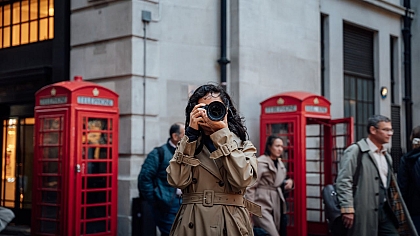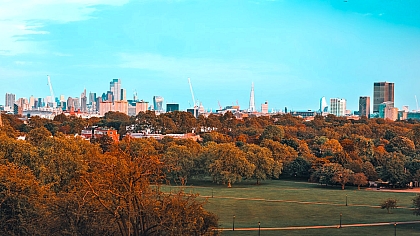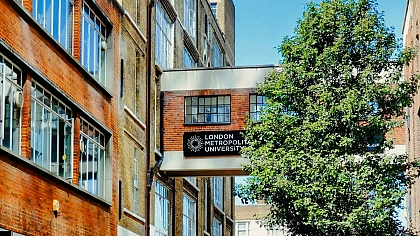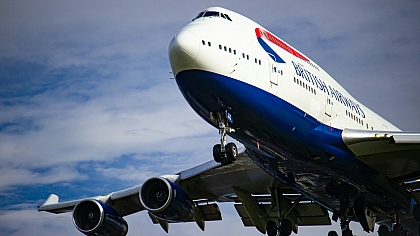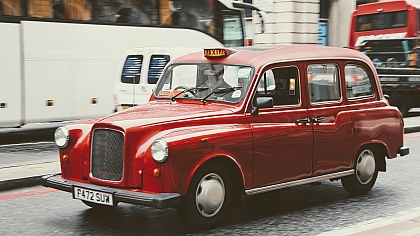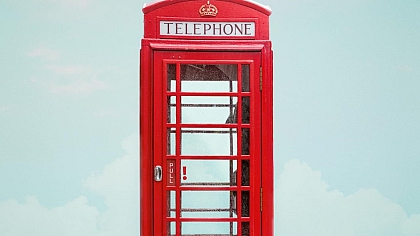
The Wonders of Chinatown: A Culinary & Cultural Adventure in London
Situated in the heart of London’s bustling West End, Chinatown is a vibrant cultural hub that draws visitors from all corners of the globe. This dynamic district, located just a short walk from Leicester Square, offers a unique blend of traditional Chinese culture and modern London life.
Bright red lanterns sway above pedestrian streets, and the aroma of authentic Chinese cuisine fills the air. Chinatown provides a snapshot of East Asia in the heart of London, where ancient traditions and contemporary culture come together in perfect harmony.
The History of London's Chinatown
Chinatown, as we know it today, wasn’t always located in its current spot near Leicester Square. The roots of London’s Chinatown can be traced back to the late 19th century in Limehouse, in London’s East End, where Chinese immigrants first settled, largely due to the growth of Britain’s maritime trade. Limehouse was a bustling, albeit impoverished, area. It was home to a small community of Chinese sailors and workers, with the first Chinese businesses emerging as cafés and boarding houses for the local seafaring population.
However, post-World War II redevelopment projects led to a decline in the Limehouse area, and the Chinese community gradually shifted to Soho in the West End during the 1950s and 60s. As Chinese restaurants and businesses took root in this new location, Chinatown’s identity began to solidify. The Chinese population expanded, and the neighbourhood transformed into the cultural centre it is today. By the late 20th century, Chinatown had become a popular destination not only for the Chinese community but also for Londoners and tourists eager to experience its rich culture and delicious cuisine.
The Significance of Chinatown in Modern London
Today, Chinatown stands as a symbol of London’s multicultural identity. It serves as a bridge between Eastern and Western cultures, offering a taste of traditional Chinese life in the heart of one of the world’s most cosmopolitan cities. Beyond its role as a popular tourist attraction, Chinatown is also an important community hub for London’s Chinese residents, providing access to groceries, traditional medicines, and a place to celebrate important festivals and traditions.
Walking through Chinatown, you’ll see more than just restaurants and shops. You’ll witness the resilience of a community that has carved out its own space in one of the most famous cities in the world. Chinatown’s streets are alive with tradition, yet they constantly evolve, reflecting the dynamic nature of the city around it.
Where is Chinatown?
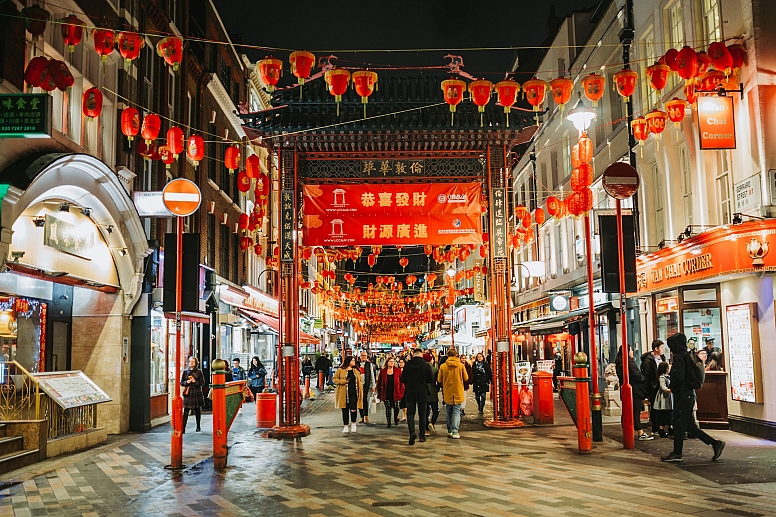
Chinatown is centrally located in London’s vibrant West End, nestled between the entertainment district of Leicester Square and the shopping haven of Soho. Situated around Gerrard Street, this compact but lively neighbourhood is easily accessible and forms part of one of the most iconic and culturally diverse areas in London. The streets of Chinatown are primarily pedestrianized, making it easy for visitors to explore the area at a relaxed pace.
Location and Surrounding Landmarks
London’s Chinatown is perfectly positioned for those looking to explore other parts of the West End. To the east, Leicester Square offers a lively atmosphere, known for its theatres, cinemas, and the bustling crowds that gather for film premieres. Just a short stroll west of Chinatown, you’ll find the trendy boutiques, cafés, and bars of Soho, one of London’s most eclectic neighbourhoods.
To the south, Trafalgar Square with its historic monuments, galleries, and museums is just a ten-minute walk away. Piccadilly Circus, with its famous neon signs and proximity to Regent Street’s shopping district, is also just a few minutes away on foot. Chinatown’s prime location makes it an ideal stop for anyone exploring central London, offering an authentic cultural experience near some of the city’s top attractions.
How to Get There
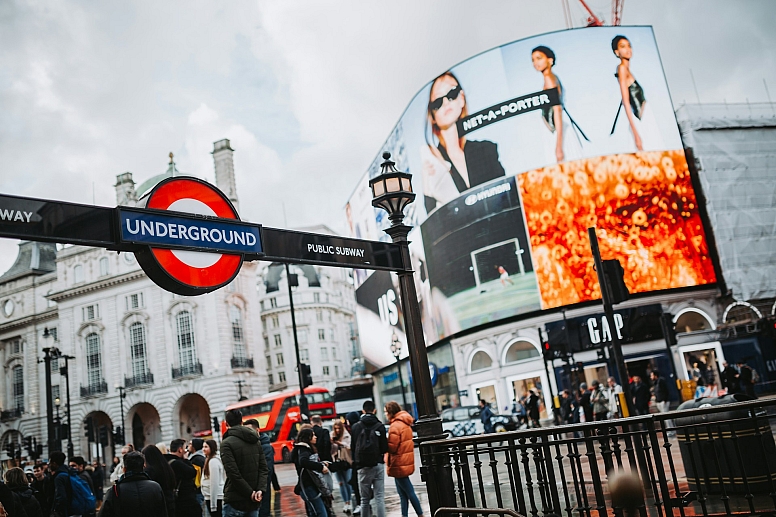
Getting to Chinatown is straightforward, thanks to its excellent public transport connections. London’s extensive underground system, buses, and pedestrian-friendly streets make it highly accessible.
-
By Tube: The nearest underground stations are Leicester Square (Northern and Piccadilly lines) and Piccadilly Circus (Bakerloo and Piccadilly lines). Both stations are just a short walk from Chinatown, and from there, it’s easy to navigate to Gerrard Street and the surrounding roads.
-
By Bus: Several bus routes pass through or near Chinatown, including those servicing Leicester Square, Shaftesbury Avenue, and Piccadilly Circus. Bus routes like 14, 19, 24, 29, and 176 provide convenient access to this part of London.
-
By Walking: For those already in the West End, Chinatown is easily accessible on foot. From Covent Garden, Soho, or Oxford Street, it’s only a short walk through the lively streets of central London.
Chinatown’s pedestrianized nature ensures a calm, traffic-free experience once you’re there, allowing visitors to stroll around, enjoy the sights, and pop into the many shops and restaurants lining the streets without having to worry about busy roads.
Exploring the Culture of Chinatown
Chinatown is much more than a destination for food and shopping; it’s a rich cultural enclave that reflects the heart and soul of Chinese tradition within London’s fast-paced metropolis. As you wander through its narrow, bustling streets, you’ll be greeted with the sights, sounds, and scents of a community that is deeply rooted in its heritage yet constantly evolving with the times.
Chinese Architecture and Decorative Elements
One of the most striking features of London’s Chinatown is its architecture. While the area consists primarily of typical London-style buildings, the Chinese influence is unmistakable, especially in the colourful decorations that adorn the streets. As you step into Gerrard Street, you’ll notice the traditional Chinese gates (known as paifang) that welcome visitors to the neighbourhood. These beautifully ornate gates, painted in vibrant reds and golds, are symbolic of good fortune and prosperity, and they give Chinatown its unmistakable character.
Above the streets, you’ll find hundreds of red paper lanterns strung together, a striking visual symbol commonly associated with Chinese festivals and celebrations. These lanterns create an enchanting atmosphere, particularly at night when they are illuminated, casting a warm, inviting glow over the streets. As you explore further, you’ll spot intricate dragon and lion statues, symbols of strength, good luck, and protection in Chinese culture, positioned throughout the district.
Beyond the aesthetics, the architecture of Chinatown also reflects elements of feng shui, the ancient Chinese art of harmonizing individuals with their surrounding environment. Many businesses and establishments are arranged in a way that aligns with these principles, ensuring a balance between natural and man-made elements for optimal flow of energy.
Cultural Festivals and Events
One of the most exciting aspects of Chinatown is its role as a hub for Chinese cultural celebrations, with the biggest event being the Chinese New Year festivities. Every year, Chinatown bursts into life with elaborate parades, colourful costumes, traditional performances, and cultural showcases. It’s the largest Chinese New Year celebration outside of Asia and attracts thousands of visitors from all over the world.
During this time, Chinatown’s streets are transformed into a carnival of music, dance, and vibrant displays of symbolic Chinese dragon and lion dances. Streets are lined with stalls offering traditional Chinese foods, arts, and crafts, and visitors can take part in activities such as calligraphy workshops, tea ceremonies, and lantern-making.
Other annual events include the Mid-Autumn Festival, also known as the Moon Festival, where locals celebrate by exchanging mooncakes (a traditional Chinese pastry) and lighting lanterns to signify the harvest season. Chinatown also hosts smaller cultural events throughout the year, including traditional Chinese opera performances, art exhibitions, and martial arts demonstrations, making it a year-round destination for cultural exploration.
Language and Traditions
The vibrant multicultural atmosphere of Chinatown means you’ll hear both Mandarin and Cantonese spoken widely by locals, alongside English. Many of the signs in the area are bilingual, written in both Chinese characters and English. Although most visitors won’t need to speak Chinese to navigate the area, you may find it enriching to learn a few simple phrases like "nǐ hǎo" (hello) or "xiè xiè" (thank you), which can go a long way in appreciating the culture.
Chinatown remains deeply connected to the traditions and values of the Chinese community. The practice of Tai Chi, a Chinese martial art known for its slow, deliberate movements and health benefits, is often visible in local parks and community spaces. Visitors can also find shops selling traditional Chinese medicinal herbs and remedies, which are rooted in ancient practices passed down through generations.
Tai Chi and Traditional Health Practices
If you visit Chinatown early in the morning, you might spot locals practising Tai Chi, a graceful form of Chinese martial art known for its health benefits and meditative qualities, as well as its slow, graceful movements and is often performed in parks and open areas, especially in the mornings or during community events.
In Chinatown, you might find groups of people gathering in public parks or open spaces, engaging in Tai Chi sessions. This practice not only promotes physical health and relaxation but also serves as a way to connect with cultural heritage.
Visitors are often welcome to observe, and sometimes even join in, making it a great opportunity to experience the cultural aspects of Chinatown firsthand. Some community groups offer Tai Chi classes, allowing visitors to try their hand at this ancient practice. If you're interested, you could ask residents or community centres about any scheduled classes or practice sessions while you’re there!
Food and Dining in Chinatown
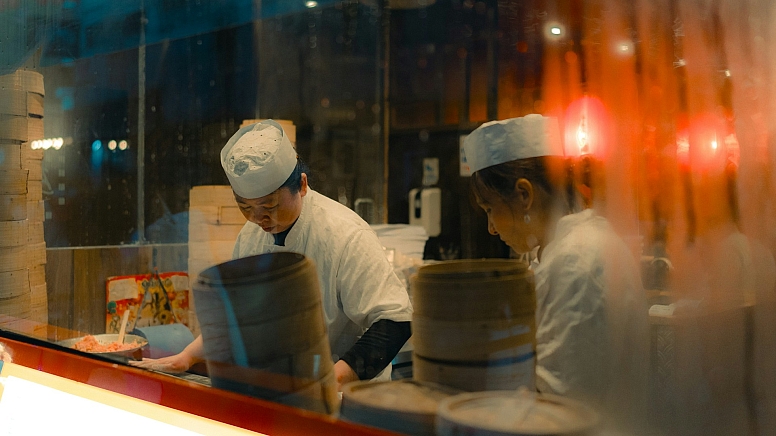
London’s Chinatown is a true haven for food lovers, offering a rich diversity of authentic Chinese and East Asian cuisine. From comforting bowls of noodles to vibrant stir-fried dishes and exquisite dumplings, Chinatown’s culinary scene is perfect for those looking to explore new flavours or indulge in traditional favourites. Whether you’re after a sit-down meal at one of its many restaurants or are keen to sample some street food, Chinatown promises an unforgettable dining experience.
Iconic Restaurants to Visit
Chinatown is packed with restaurants that highlight the best of Chinese cuisine, each bringing its specialities to the table. Here are a few must-visit places:
-
Four Seasons: Known for its mastery of Cantonese cuisine, Four Seasons is celebrated for its roasted meats. A standout is their roasted duck, prepared with perfectly crisp skin and tender, flavorful meat. This classic dish is served alongside steamed rice and vegetables, creating a deliciously balanced meal.
-
Golden Dragon: A go-to spot for dim sum, Golden Dragon offers a wide selection of small plates that are ideal for sharing. From shrimp dumplings to vegetable spring rolls, every dish is crafted with care. This restaurant is perfect for those seeking an authentic dim sum experience in a lively, traditional setting.
-
Café TPT: Café TPT specializes in Hong Kong-style street food and comfort dishes. Their clay pot rice dishes, seafood specialities, and noodle soups are crowd favourites, offering a warm and hearty meal for diners. The casual, bustling atmosphere makes it a great spot for a quick bite.
-
BaoziInn: Known for its Northern Chinese street food, BaoziInn delivers bold flavours, especially in its Sichuan-inspired dishes. Their spicy noodles, vegetable-filled dumplings, and signature skewers bring the heat and vibrant flavours of Sichuan cuisine to life, making it a must-visit for spice lovers.
Popular Dishes and Culinary Experiences
Chinatown provides an incredible opportunity to sample a variety of regional Chinese dishes. Here are some highlights:
-
Dim Sum: Originating from Cantonese cuisine, Dim Sum is a collection of small, flavourful dishes often served in bamboo baskets. Popular items include shrimp dumplings, vegetarian rolls, and steamed buns filled with a variety of ingredients. Dim sum is traditionally enjoyed with tea and is a perfect way to share multiple dishes in one sitting.
-
Peking Duck: This classic dish from Beijing is one of the most well-loved in Chinatown. Peking duck is served with thin pancakes, fresh cucumbers, and hoisin sauce. Diners wrap slices of crispy duck in the pancakes, creating a rich and flavorful bite. The dish’s combination of textures and flavours makes it a standout meal.
-
Sichuan Hotpot: Known for its bold flavours and communal style of eating, Sichuan Hotpot is an immersive dining experience. Diners gather around a pot of simmering broth, choosing ingredients such as vegetables, tofu, seafood, and noodles to cook in the pot. This dish is particularly known for its spicy kick, making it a great option for those who enjoy bold flavours.
-
Noodles and Rice Dishes: Noodles and rice are staples of Chinese cuisine, and Chinatown offers a wide variety of both. From stir-fried noodles packed with vegetables to fragrant rice dishes served with delicate sauces, these meals offer comforting and satisfying flavours. Classic noodle soups, such as beef brisket or seafood varieties, provide hearty and warming options, perfect for colder days.
Street Food Options
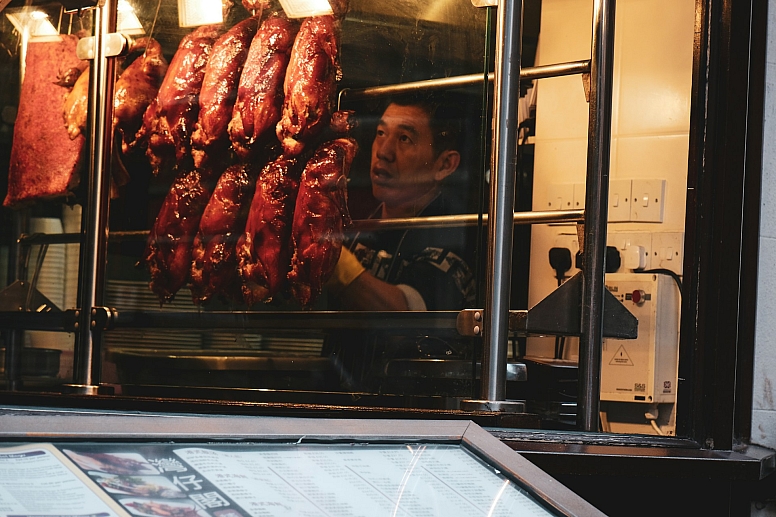
For a more casual experience, Chinatown is home to a vibrant street food scene, offering an array of snack-sized dishes and light meals that are perfect for eating on the go. Some of the best street food items include:
-
Bao Buns: These soft, steamed buns are filled with a variety of savoury ingredients, including marinated chicken, tofu, and crispy vegetables. They’re a delicious, handheld option for a quick snack or light lunch.
-
Jianbing (Chinese Crepes): This popular street food, originating from northern China, is a savoury crepe made from wheat and mung bean flour, filled with eggs, scallions, and other flavorful fillings. It’s crispy on the outside and soft on the inside, creating a wonderful combination of textures.
-
Bubble Tea: A Taiwanese export that has become hugely popular in Chinatown, bubble tea consists of tea (often milk tea) combined with chewy tapioca pearls. With flavours ranging from traditional black tea to fruity blends, bubble tea is a refreshing treat that you’ll find at several spots throughout Chinatown.
-
Grilled Skewers: For those craving something savoury, grilled skewers of marinated chicken, vegetables, or seafood are a great option. These skewers are often cooked on open grills, offering a smoky, charred flavour with a hint of spice or sweetness, depending on the marinade.
Shopping in Chinatown
Chinatown is not only a destination for food lovers but also a treasure trove for shoppers. Whether you’re looking for authentic Chinese groceries, beautiful teas, traditional remedies, or quirky souvenirs, Chinatown’s bustling shops and markets have something for everyone. The diverse range of goods available reflects the rich cultural heritage of the area, blending traditional Chinese items with modern, international trends. It’s a great place to discover both the familiar and the unusual.
Authentic Chinese Goods: Groceries, Teas, and Herbs
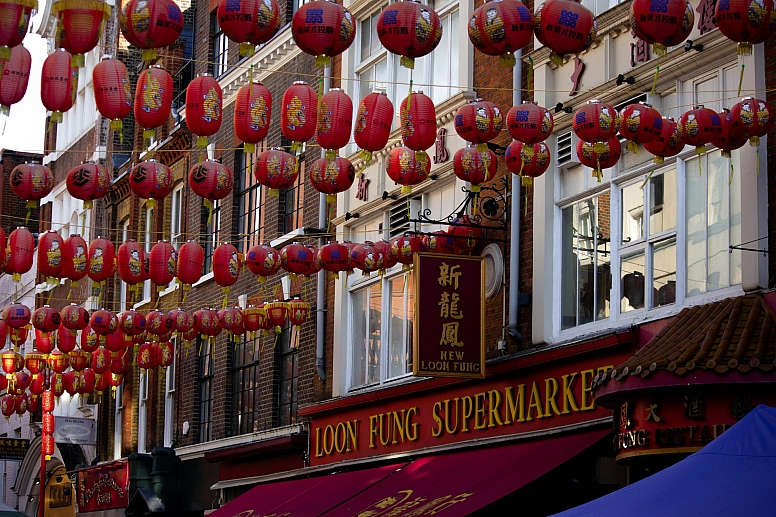
Chinatown is home to many well-stocked grocery stores that provide a wide selection of authentic Chinese ingredients. These shops are an essential resource for London’s Chinese community, offering hard-to-find ingredients that are staples in Chinese cooking. They are also a fascinating exploration ground for food enthusiasts looking to expand their pantry with new flavours and products.
-
Grocery Stores: Shops like New Loon Moon and SeeWoo are famous for their wide selection of products. Visitors can find everything from fresh vegetables, such as pak choi and Chinese cabbage, to a wide range of sauces, including soy, hoisin, and oyster sauce. These stores are also the go-to place for a variety of noodles, from rice noodles to udon, as well as exotic mushrooms, tofu, and a range of Asian spices.
-
Teas: Chinatown is a haven for tea lovers, with several speciality shops offering a dazzling array of Chinese teas. Green tea, jasmine tea, and oolong tea are just a few of the varieties on offer, often sold in beautifully decorated tins. Some stores also carry rarer varieties, such as pu-erh tea, known for its deep, earthy flavour and health benefits. Tea sets and accessories, such as ornate teapots and tea strainers, make for thoughtful gifts or a great souvenir to bring home.
-
Herbal Medicines: For those interested in traditional Chinese medicine, several shops offer herbal remedies, dried goods, and health supplements that have been used for centuries in Chinese healing practices. Products like ginseng, dried goji berries, and herbal tonics are commonly found, providing insight into ancient methods of balancing health and wellness. Additionally, many visitors to Chinatown seek out traditional Chinese medicine practices, such as acupuncture. Several stores in the area provide consultations, offering remedies that draw on centuries-old Chinese health traditions.
Gift Shops and Unique Souvenirs
Shopping in Chinatown goes beyond the traditional, with a delightful mix of unique and fun items that cater to a variety of tastes. From kawaii-inspired stationery to ornate Chinese trinkets, Chinatown’s gift shops are filled with treasures waiting to be discovered.
-
Kawaii Stationery: Chinatown offers a wonderful selection of kawaii (cute) stationery that has gained immense popularity, particularly among younger visitors. Shops like ArtBox and smaller boutiques feature adorable notebooks, pens, and stickers, often adorned with cartoon characters like pandas, bunnies, and other whimsical creatures. These items, inspired by Japanese pop culture, are not only fun but also practical for adding a personal, playful touch to your daily writing routine.
-
Lucky Charms and Trinkets: Souvenir hunters will find plenty of small, meaningful items to take home. Many shops sell Chinese charms, such as jade bracelets or feng shui coins. Red and gold are common colours for these items, symbolizing good fortune and success. You’ll also come across traditional Chinese fans, porcelain figurines, and silk embroidery, each offering a glimpse into Chinese craftsmanship.
-
Calligraphy Sets: For those with a love of art and culture, Chinatown’s shops also offer traditional Chinese calligraphy sets. These include brushes, ink stones, and rice paper, which are used in the ancient art of Chinese writing. These sets make for a thoughtful and artistic souvenir, especially for those interested in learning more about Chinese culture.
-
Asian Pop Culture and Toys: Chinatown is also a hotspot for fans of Asian pop culture. Stores offer a range of merchandise inspired by anime, manga, and K-pop, including figurines, posters, and plush toys. It’s a great place to pick up something quirky and unique, especially for younger visitors or collectors.
-
Paper Lanterns and Decorative Items: Decorative items, such as paper lanterns and silk umbrellas, can be found in abundance. These brightly coloured decorations are not only used during Chinese festivals but also make wonderful souvenirs to bring a touch of Chinatown’s festive spirit into your home.
Hidden Gems for Collectors and Craft Lovers
Chinatown also has a few hidden gems for those who love crafts and antiques. Some speciality stores offer handmade ceramics and vintage Chinese art, perfect for collectors looking for something truly unique. You might also find antique coins, traditional paintings, and small sculptures that offer a glimpse into China’s rich artistic history.
For craft lovers, Chinatown also has a number of DIY kits, such as lantern-making sets, origami paper, and Chinese knot-tying kits. These creative items allow visitors to immerse themselves in traditional Chinese art forms while taking home a piece of culture.
Cultural Experiences and Landmarks
While Chinatown is primarily known for its food and shopping, it also offers visitors a wealth of cultural experiences. Whether you’re interested in art, history, or simply soaking in the atmosphere, Chinatown has plenty to explore. Walking through the streets, you’ll encounter landmarks that embody the rich heritage of the Chinese community in London, as well as opportunities to participate in cultural activities that give deeper insight into the traditions of the area.
Chinese Gates and Street Decor

One of the most iconic features of Chinatown is its beautifully designed paifang gates, which mark the entrances to the district. These ornate, traditional Chinese archways are grand in size and rich in colour, primarily painted in red and gold—colours that symbolize luck and prosperity in Chinese culture. The gate on Wardour Street is the largest and most intricate in the neighbourhood, a symbol of Chinatown’s cultural identity and a perfect place for a photo opportunity.
The streets of Chinatown are also adorned with red lanterns, strung high above, creating a festive and vibrant atmosphere, particularly during the evenings when the lanterns are illuminated. These lanterns, which are traditionally used to celebrate festivals and special occasions, are a hallmark of Chinese culture, symbolizing vitality and good fortune.
Chinatown Pavilion
A standout structure in Chinatown is the Chinatown Pavilion, a traditional-style Chinese pagoda located at the centre of Newport Place. The pagoda adds to the area’s authentic ambience, offering visitors a quiet spot to pause and take in the surrounding architecture and decorations. The Pavilion is also an excellent backdrop for cultural events, often serving as a focal point during festivals like Chinese New Year or the Mid-Autumn Festival.
Cultural Events and Celebrations
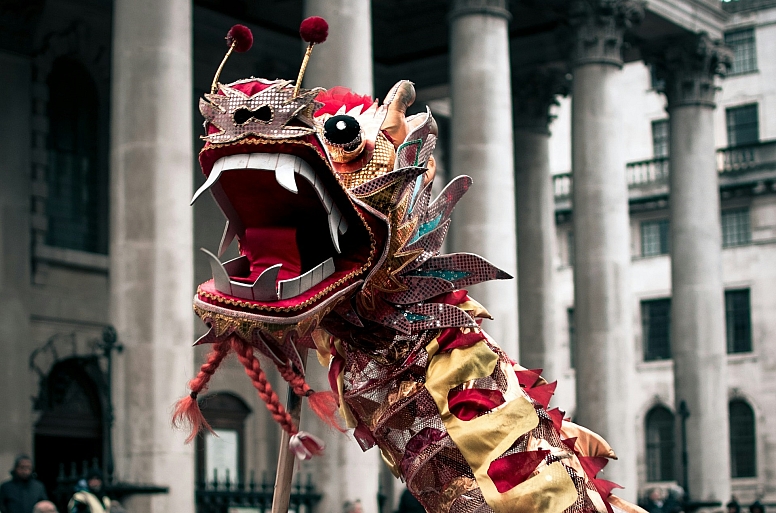
Chinatown is at its most vibrant during the celebration of Chinese New Year, which is undoubtedly the biggest and most significant event in the area. Held in either January or February depending on the lunar calendar, the festival is a lively, colourful spectacle that draws thousands of visitors to Chinatown. The celebrations typically include:
-
Dragon and Lion Dances: These performances are the highlight of the festivities, symbolizing power, prosperity, and good fortune. The dancers, dressed in elaborate dragon and lion costumes, weave through the streets to the beat of drums, cymbals, and gongs.
-
Firecrackers and Lanterns: In keeping with Chinese tradition, firecrackers are used, while red lanterns—hung throughout the district—symbolize happiness and good fortune. The sight of thousands of lanterns lighting up Chinatown is an unforgettable experience.
-
Food Stalls and Cultural Performances: During the festival, the streets are lined with food stalls offering traditional Chinese treats such as dumplings, rice cakes, and tang yuan (sweet rice balls). Cultural performances, including acrobatics, martial arts displays, and traditional music, also take place throughout the day, showcasing China’s rich heritage.
Beyond Chinese New Year, the Mid-Autumn Festival is another significant celebration in Chinatown. Taking place in September or October, this festival is celebrated with mooncakes, lanterns, and gatherings, all symbolizing reunion and gratitude. Visitors can take part in lantern-making workshops and experience the warmth of this harvest festival.
Art Galleries and Exhibitions
For art enthusiasts, Chinatown offers a few small yet significant galleries and spaces that display Chinese contemporary art and traditional works. Occasionally, you can find exhibitions that highlight the blend of East and West, showcasing pieces that explore the Chinese immigrant experience in London.
Entertainment and Activities
Chinatown is a vibrant hub of entertainment, offering visitors a mix of traditional and modern activities that celebrate Chinese culture. From engaging in games to exploring cultural centres, there are numerous ways to experience the unique charm of this district. Here are some of the key activities and venues that contribute to the lively atmosphere of Chinatown.
Traditional Chinese Activities
One of the most notable aspects of Chinese culture is its array of traditional games and pastimes. Chinatown provides a fantastic opportunity to immerse yourself in these activities, particularly those that are often enjoyed in communal settings.
-
Mahjong Parlours: Mahjong is a classic Chinese game that combines skill, strategy, and luck. Visitors can experience this social game in parlours scattered throughout Chinatown. Many local establishments offer tables for players of all skill levels, making it accessible for newcomers eager to learn. Participating in a game can be a fun way to connect with locals and fellow visitors, as well as to understand a vital aspect of Chinese social culture. Some parlours even offer lessons for those new to the game, providing a welcoming environment to learn and enjoy.
-
Chinese Calligraphy Workshops: For those interested in the arts, various shops and cultural centres offer calligraphy workshops. These classes introduce participants to the delicate art of Chinese writing, where they can learn the techniques and meanings behind the characters. It’s a unique opportunity to connect with Chinese culture through a hands-on experience, and participants often leave with a piece of art they created themselves.
-
Tea Ceremonies: Engaging in a traditional Chinese tea ceremony is another enriching experience available in Chinatown. Several tea houses provide demonstrations of this ancient ritual, showcasing the importance of tea in Chinese culture. Participants can learn about different types of tea, the proper brewing methods, and the significance of each step in the ceremony. It’s not just about tasting the tea; it’s also about appreciating the artistry and mindfulness behind the practice.
Chinese Cultural Centres and Venues
As well as Street Performances and Festivals, Chinatown is also home to several cultural centres and venues that promote and preserve Chinese arts, language, and heritage.
-
The Chinese Community Centre: This hub serves as a focal point for the Chinese community in London, offering a range of programs and events aimed at fostering cultural exchange and understanding. Visitors can participate in language classes, cultural workshops, and community events that highlight traditional festivals, food, and crafts. The centre often hosts exhibitions and showcases local artists, providing insight into the contemporary cultural landscape of the Chinese community in London.
-
The London Confucius Institute: Located near Chinatown, this institute is dedicated to promoting Chinese languages and culture. It offers courses in Mandarin and hosts various cultural events, including lectures, film screenings, and exhibitions. Visitors interested in learning more about the Chinese languages and culture can attend workshops and events that delve deeper into topics like Chinese philosophy, history, and art.
-
Theatre and Performing Arts: Chinatown is in proximity to several theatres in the West End, making it a prime location for those looking to enjoy performances that celebrate Asian culture. Some venues occasionally host Chinese-themed shows or productions that highlight aspects of Chinese storytelling, music, and dance. Keep an eye on local listings for any special events during your visit.
With such a rich array of entertainment options, Chinatown offers visitors numerous ways to engage with its vibrant culture. Whether you’re trying your hand at mahjong, participating in a tea ceremony, or exploring the offerings of cultural centres, there is always something happening in this lively district. Engaging in these activities not only enriches your visit but also provides a deeper understanding of the traditions and community that thrive in Chinatown.
Chinatown’s Hidden Gems
While Chinatown is well-known for its vibrant atmosphere, delicious food, and cultural landmarks, it also hides a wealth of lesser-known experiences waiting to be discovered. This section highlights off-the-beaten-path activities, local secrets, and unique places that offer a more intimate glimpse into the culture and community of Chinatown.
Off-the-Beaten-Path Experiences
-
Secret Tea Shops: While popular tea houses are bustling with visitors, several smaller tea shops offer a quieter, more authentic experience. These hidden gems often feature a carefully curated selection of speciality teas that are hard to find elsewhere. For example, look for shops tucked away on side streets that offer rare blends or unique brewing techniques. Engaging with knowledgeable staff can lead to discovering new favourites and learning about the history and health benefits of different teas.
-
Artisan Shops: Beyond the main shopping streets, some artisanal shops specialize in traditional crafts, such as hand-painted porcelain, silk products, and intricate woodwork. These shops often feature local artisans’ work, allowing visitors to find one-of-a-kind pieces that represent authentic Chinese craftsmanship. Keep an eye out for workshops where you can observe artisans at work or even try your hand at creating something special.
-
Historic Sites: While the main thoroughfares are bustling, some historical sites within Chinatown are often overlooked. For example, you can find Gordon Ramsay's Union Street Café nearby, which has connections to the Chinese community's early history in London. Exploring these sites can provide context to Chinatown's evolution and the stories of the people who have shaped it over the years.
Local Secrets and Lesser-Known Places
-
Hidden Garden Areas: Tucked away behind the hustle and bustle, some small parks and gardens offer a peaceful respite from the lively streets. The Chinese Garden in the City of London, for instance, provides a serene environment where visitors can enjoy a moment of quiet reflection. These hidden green spaces often feature beautiful landscaping, traditional sculptures, and a calm atmosphere, perfect for a break during your exploration.
-
Cultural Workshops: While many visitors are drawn to the main attractions, some local community centres host unique workshops that are less publicized. These may include cooking classes, calligraphy sessions, or even Chinese martial arts classes. Participating in these activities not only allows you to learn new skills but also to meet locals and gain insight into their way of life.
-
Local Bakeries: Beyond the well-known restaurants, keep an eye out for small bakeries that offer traditional Chinese pastries and sweets. These local spots may not be as flashy as their counterparts, but they often serve up authentic treats that are beloved by the community. Items like pineapple buns, mochi, and egg tarts are often available, providing a delightful taste of traditional Chinese baking.
-
Underground Art and Music Scene: Chinatown has a burgeoning underground art scene, with local artists often showcasing their work in pop-up galleries or community events. Keep an eye on social media or local listings for announcements of art exhibitions, performances, or poetry readings. Engaging with this scene can offer a fresh perspective on contemporary Chinese culture in London.
Chinatown is brimming with hidden treasures that often go unnoticed by the casual visitor. By venturing beyond the main attractions, you can uncover unique experiences that provide a deeper understanding of the culture, artistry, and community spirit of this vibrant area. Whether you’re enjoying artisan crafts, indulging in local pastries, or participating in workshops, these hidden gems add richness to your Chinatown experience.
The Best Time to Visit Chinatown
Chinatown is a lively destination year-round, but certain times offer unique experiences that can enhance your visit. Understanding the seasonal highlights, peak tourist times, and what to expect during festive periods versus off-peak times will help you make the most of your trip.
Seasonal Highlights and Peak Tourist Times
-
Spring: As the weather warms up, Chinatown comes alive with outdoor dining and events. Spring is particularly vibrant with the celebration of Chinese New Year, which typically falls between late January and mid-February, depending on the lunar calendar. The festive atmosphere, combined with traditional decorations, creates a truly immersive experience.
-
Summer: The hotter weather brings an influx of tourists, as families and travellers flock to London. This is a fantastic time to enjoy outdoor dining and street performances. However, be prepared for larger crowds, especially during weekends and holiday periods.
-
Autumn: As the weather cools, autumn offers a more relaxed experience in Chinatown. The Mid-Autumn Festival, celebrated in September or October, features mooncake tastings and lantern displays, creating a beautiful setting in the streets. This festival is less crowded than Chinese New Year, making it a pleasant time to explore the area while still enjoying cultural events.
-
Winter: Winter is a quieter time in Chinatown, especially after the holiday season. While it may lack the vibrant festivals of spring and autumn, this period can be ideal for those looking to avoid crowds. Visitors can enjoy a more leisurely exploration of shops and restaurants. The festive decorations during Christmas add a unique charm to the area, with lights and displays enhancing the streets' ambience.
What to Expect During Festive Periods vs. Off-Peak
-
Festive Periods: During major festivals like Chinese New Year, expect the streets of Chinatown to be bustling with activity. The atmosphere will be festive, filled with music, dance performances, and special food stalls. It’s advisable to arrive early to secure a good viewing spot for parades and events. Many restaurants will also offer special menus and dishes for these celebrations, providing an opportunity to try seasonal delicacies.
Keep in mind that certain attractions may have altered hours or special events, so it’s wise to check in advance. The vibrant decorations and lively performances create an unforgettable experience that highlights the richness of Chinese culture.
-
Off-Peak Times: Visiting during the off-peak season allows for a more intimate experience. You can explore the shops, restaurants, and cultural venues without the hustle and bustle of crowds. This period is ideal for those interested in engaging with local businesses and learning about the community. You may find that some venues offer workshops or events during quieter times, giving you the chance to connect with locals and discover hidden gems.
Chinatown has something to offer throughout the year, with each season bringing its charm and experiences. Whether you’re eager to immerse yourself in the vibrant celebrations of Chinese New Year or prefer the quieter, reflective atmosphere of winter, timing your visit to coincide with these seasonal highlights can greatly enhance your experience. Understanding what to expect during festive periods and off-peak times will allow you to enjoy all that Chinatown has to offer at your own pace.
Nearby Attractions

Chinatown is conveniently located in the heart of London, making it easy for visitors to explore a variety of nearby attractions. This section highlights some of the most popular sites nearby, including cultural landmarks and entertainment districts that complement your visit to Chinatown.
Soho and the West End
-
Soho: Just a stone’s throw away from Chinatown, Soho is a vibrant district known for its eclectic atmosphere, diverse dining options, and lively nightlife. Strolling through the streets of Soho, you'll find everything from trendy cafes and boutique shops to art galleries and theatres. The area is famous for its bustling atmosphere and has long been a hub for creatives, making it an excellent destination for those seeking to experience London’s artistic side. Don't miss Berwick Street Market, where you can grab delicious street food and fresh produce.
-
The West End: Adjacent to Chinatown, the West End is London's premier theatre district, boasting a wide array of world-class productions. From long-running musicals to cutting-edge plays, there’s something for everyone. After enjoying a meal in Chinatown, catching a show in the West End is a perfect way to round off your evening. Many theatres also have restaurants nearby, offering pre-theatre dining options that complement your cultural experience.
Cultural and Historical Landmarks
-
Trafalgar Square: A short walk from Chinatown, Trafalgar Square is a significant cultural landmark in London. Home to the iconic Nelson's Column, the square is often filled with events, festivals, and performances. The National Gallery, located on the square, houses an impressive collection of European paintings, making it a must-visit for art lovers. Whether you take a moment to enjoy the fountains or admire the art, Trafalgar Square adds to the cultural richness of your visit.
-
The British Museum: A bit further afield but still within easy reach, the British Museum is one of the world’s most renowned cultural institutions. Housing a vast collection of art and antiquities from around the globe, it’s an essential stop for any visitor to London. Exhibits such as the Rosetta Stone and the Elgin Marbles are highlights that showcase the depth of human history. Admission is free, though special exhibitions may require tickets.
-
Covent Garden: Located a short distance from Chinatown, Covent Garden is known for its vibrant market, street performances, and chic shops. The area features a range of dining options, making it a great place to grab a bite before or after exploring Chinatown. The Royal Opera House is also situated here, offering visitors the chance to experience high-quality performances in a stunning venue.
Parks and Green Spaces
-
Leicester Square: Just north of Chinatown, Leicester Square is another bustling hub where you can find cinemas, restaurants, and entertainment. The square often hosts outdoor events and screenings, particularly during the summer months. The nearby Chinese New Year Celebrations also often spill into Leicester Square, creating a festive atmosphere.
-
St. James's Park: A bit further but worth the walk, St. James's Park is one of London's most picturesque parks, offering tranquil paths, beautiful flowerbeds, and stunning views of Buckingham Palace. The park is perfect for a stroll or a peaceful picnic, providing a green oasis in the bustling city. It’s an excellent place to unwind after a day of exploring.
Chinatown's central location allows for easy access to a variety of attractions that enhance your visit to London. Whether you’re exploring the lively streets of Soho, enjoying a world-class performance in the West End, or taking in the history of nearby cultural landmarks, there’s plenty to see and do just a short walk away. Combining your Chinatown experience with these nearby attractions will ensure a well-rounded and memorable visit to this vibrant part of the city.
Practical Tips for Visiting Chinatown
To make the most of your visit to Chinatown, it’s essential to be prepared. This section offers valuable advice on what to do (and what to avoid), useful language tips, and practical information on accessibility and safety.
Dos and Don’ts in Chinatown
-
Do Explore: Take your time to wander through the streets and alleys of Chinatown. Don’t just stick to the main roads; some of the best experiences and hidden gems are found off the beaten path.
-
Do Try New Foods: Be adventurous with your food choices! Don’t hesitate to try unfamiliar dishes, as Chinatown offers a wide variety of culinary delights. Ask locals or staff for recommendations on must-try items.
-
Don’t Rush Your Visit: The atmosphere in Chinatown is best enjoyed at a leisurely pace. Avoid cramming too much into a single visit; instead, allow yourself time to savour the ambience, food, and culture.
-
Don’t Be Disrespectful: When participating in cultural activities or visiting religious sites, be respectful of the customs and traditions. Always ask for permission before taking photos of people or ceremonies.
Language Tips and Useful Phrases
While many people in Chinatown speak English, knowing a few basic Chinese phrases can enhance your experience and show respect for the culture. Here are some useful phrases to consider:
- Nǐ hǎo (你好): Hello
- Xièxiè (谢谢): Thank you
- Qǐng (请): Please
- Wǒ yào zhège (我要这个): I want this
- Duō shǎo qián? (多少钱?): How much is this?
- Zài nǎlǐ? (在哪里?): Where is...? (useful for asking for directions)
You might also notice some signs and menus featuring both English and Chinese characters. If you see something that piques your interest, don’t hesitate to ask about it!
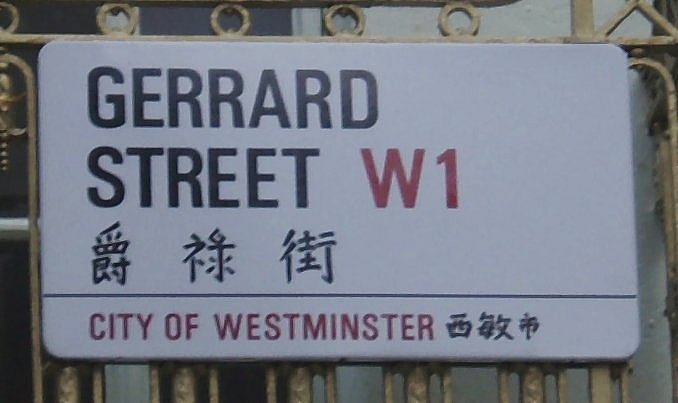
Accessibility and Safety Tips
-
Accessibility: Chinatown is relatively accessible, but some areas may have cobbled streets that could be challenging for those with mobility issues. Most restaurants and shops strive to be inclusive, with many offering wheelchair access. If you have specific accessibility needs, check in advance or call ahead to confirm that a particular venue can accommodate you.
-
Safety: Chinatown is generally a safe area for visitors. However, like in any busy urban environment, it’s important to stay vigilant and be aware of your surroundings. Keep your belongings secure and be cautious in crowded spaces, especially during festival times when it can get particularly busy.
-
Public Transport: Chinatown is well-served by public transport, with several tube stations nearby, including Leicester Square, Piccadilly Circus, and Covent Garden. Buses also run frequently in the area. If you're exploring further afield, consider purchasing an Oyster Card or using contactless payment methods for ease of travel.
-
Emergency Services: In case of emergencies, it’s helpful to know the local emergency numbers. In the UK, you can dial 999 for police, fire, ambulance, or other emergency services. If you require non-emergency medical assistance, visit a nearby pharmacy or contact NHS 111 for advice.
Being well-prepared can significantly enhance your experience in Chinatown. By understanding the dos and don’ts, learning a few key phrases, and keeping accessibility and safety in mind, you’ll be able to navigate the area confidently and enjoy all that this vibrant district has to offer. Whether it’s indulging in delicious food, exploring cultural landmarks, or participating in traditional activities, your visit to Chinatown is sure to be a memorable one.
Chinatown is more than just a destination; it is a vibrant tapestry woven from rich cultural traditions, diverse culinary experiences, and the lively spirit of community. Whether you’re drawn to its bustling streets filled with restaurants and shops, or the deeper cultural experiences offered by its traditional activities and hidden gems, Chinatown provides a unique glimpse into Chinese heritage and its influence on London.
Throughout the year, various festivals and events showcase the vibrancy of Chinese culture, allowing visitors to engage with and celebrate this rich history. From the exuberance of the Chinese New Year to the more serene celebrations of the Mid-Autumn Festival, each occasion presents an opportunity to experience the heart of the community.
The area’s central location means that Chinatown is conveniently situated near many other attractions, including the West End, Soho, and historic landmarks. This accessibility enhances the experience, allowing visitors to seamlessly blend their exploration of Chinatown with the broader cultural landscape of London.
To fully appreciate your visit, consider the practical tips shared here—embrace the local culture, engage with the community, and take time to savour both the atmosphere and the flavours of this unique district. By being respectful and open to new experiences, you will find that Chinatown offers more than just food and shopping; it presents a chance to connect with a vibrant cultural legacy.
If you're a first-time visitor or a seasoned traveller returning to this dynamic part of London, Chinatown promises a rich and fulfilling experience. From its delectable cuisine and lively entertainment to its cultural insights and hidden gems, this iconic district invites you to explore, discover, and enjoy the wonders it has to offer.
